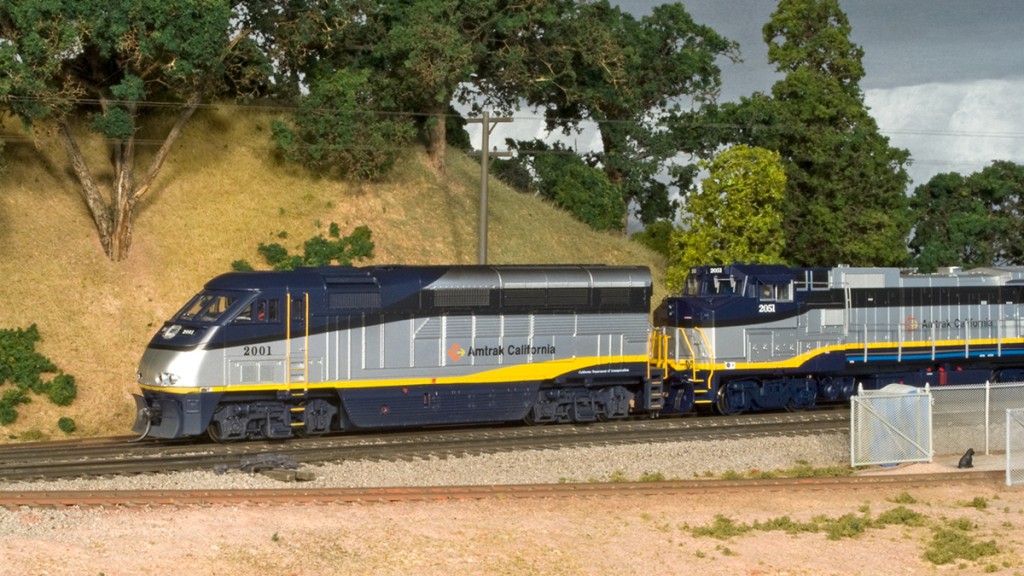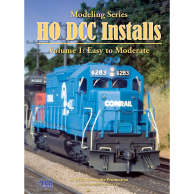
HO Athearn RTR F59PHI
Athearn Ready-to-Roll F59PHI, Amtrak California 2001
Overview
CV Programming – Digitrax DH163AT
Modifications & Extras
Review
Though technically a part of Athearn’s “Ready-to-Roll” line, the F59PHI really has more in common mechanically with the older “blue box” models. As such, I thought it would be a good candidate for the Digitrax DH163AT decoder. This decoder features a special clip-in harness that eliminates the need for soldering.
Living in the San Francisco Bay Area I have seen Amtrak California’s F59PHI locomotives many times. I certainly saw plenty of them the day we filmed A Day at Pinole! My model is decorated in the as-delivered version of the Amtrak California scheme. This paint scheme is slightly different from the modern version.
CV Programming – Digitrax DH163AT
Only common CVs or those that were changed from their default values are listed. Some settings reflect my personal preferences for speed matching and performance.
| CV | Value (decimal) | Notes |
| 2 (start speed) | 3 | This controls the minimum voltage applied to the motor at speed step 1. |
| 3 (acceleration) | 32 | This controls how quickly the locomotive changes speed when accelerating. |
| 4 (deceleration) | 26 | This controls how quickly the locomotive changes speed when decelerating. |
| 5 (top speed) | 80 | This controls the maximum voltage applied to the motor at full throttle. |
| 6 (mid speed) | 40 | This controls the voltage applied to the motor at half throttle. |
| 17 (extended address) | 199 | For locomotives with a 4-digit address, CV 17 and 18 together determine the address. To be honest I never try to set these manually. My Digitrax system does all this automatically for me when I program a 4-digit address. |
| 18 (extended address) | 209 | see CV17 |
| 29 (configuration) | 38 | The setting of CV29 is complex. See your decoder instructions. Your DCC system may set CV29 for you when programming your locomotive’s address. If you need to modify CV29, it’s best to do it after setting the address. |
Most of the detailing on this model was limited to the back end. I added free-standing grab irons, an uncoupling lever, MU hoses, and a few other small parts. I substituted NWSL wheels for the originals, as the nickel-silver wheels conduct electricity better. I also gave the model some light weathering.
Locomotive
Since this locomotive has the old-style Athearn motor and spline shafts, it is a bit noisier than Athearn’s newer hex-drive models. In spite of that it runs smoothly. This locomotive has a very heavy frame, so it should be a good puller (not that Amtrak California’s F59PHIs usually handle more than 5 coaches at a time). The frame design makes working on the locomotive a little bit difficult, as access to the drivetrain area is restricted.
Decoder
The DH163AT is a good running decoder and pretty easy to set up and program. If you have a “blue box” Athearn unit and just don’t want to have to solder, the harness makes it relatively easy to add DCC.
Using this installation is somewhat limited, though. For example, the harness is designed to work with the stock headlight, but that’s just a single bulb in the front of the unit. To really look right a locomotive like this one needs working ditch lights, red marker lights for running in reverse, etc. Fortunately the DH163 has six light outputs, so you could always go back and redo the lighting later. I eventually did this in my model.


Comments are closed.